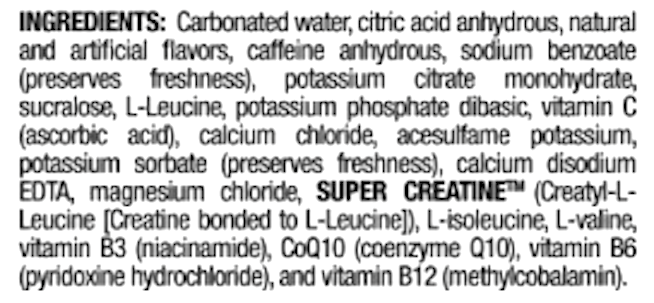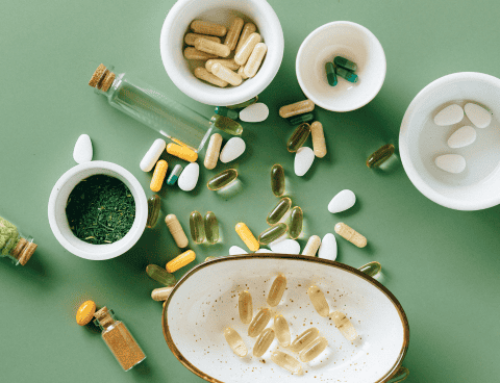Are Bang Energy Drinks Healthy?
Energy drinks are rarely a good choice.
Many shock your system with colossal amounts of caffeine and sugar in an effort to increase alertness, but that sudden spike in energy is usually followed by a brutal crash which leaves you feeling worse off than before. Most energy drinks are nutritionally equivalent to soda, and you’re smart enough to know a can of Coca-Cola isn’t doing your health any favors.
But an energy drink called BANG is rapidly gaining popularity thanks to claims and nutrition facts that seemingly stand in stark contrast to traditional options like Monster or Rockstar. With rave reviews all around the internet, is BANG really the future of energy drinks?
Are Bang Energy Drinks Actually Healthy?
Let’s take a closer look to see if BANG energy drinks are actually as healthy as some might lead you to believe.
BANG energy drinks come in a variety of flavors, but it looks like each one has identical (or near-identical) nutrition facts. One 16-ounce can of BANG contains:
- 0 calories
- 0 grams of fat
- 0mg of cholesterol
- 40mg sodium
- 85mg potassium
- 0 grams of carbohydrate
- 0 grabs of fiber
- 0 grams of sugar
- 0 grams of protein
- 50% DV of Vitamin C
- 25% DV of Niacin
- 25% DV of Vitamin B6
- 25% DV of Vitamin B12
- 2% DV of Magnesium
Compared to a 16-ounce can of Rockstar, which packs 260 calories and 62 grams of sugar, the nutrition facts look like a massive improvement.
Frequently choosing high-sugar beverages is a serious hazard to your health. Not only can it lead to poor body composition, but it significantly increases your risk of several unfavorable health outcomes. Regular consumption of beverages high in added sugar has been associated with an increased risk of cancer, heart disease and type 2 diabetes.
The American Heart Association recommends a limit of 24 grams per day for women and 36 grams per day for men. Each gram of sugar also contains 4 calories, so high amounts of sugar can quickly send the calorie total skyrocketing (95% of the calories in the aforementioned 16-ounce can of Rockstar come from sugar, for example).
Bang Energy Drink Ingredients
BANG still packs plenty of sweetness despite the lack of sugar. How? Let’s look at the ingredients:
Whew—that’s a lot of words most people don’t recognize.
Sucralose is the secret of how BANG can taste so good despite containing zero grams of sugar. Sucralose is a common artificial sweetener that is 320 to 1,000 times sweeter than table sugar. Splenda is one common sucralose-based sweetener. Healthline concludes that Sucralose “is probably fine to use in moderation” if your body handles it well, and it’s generally recognized as safe by the FDA.
However, it may cause issues with your gut health, and like most artificial sweeteners, it probably won’t help you decrease your overall calorie consumption in the grand scheme of things. When we consume something sweet, it signals our body to expect incoming calories. When those calories don’t arrive, as is the case with zero-calorie diet sodas or energy drinks, we often end up consuming more calories elsewhere to make up for what’s “missing.”
RELATED: Why Zero-Calorie Diet Soda Can Still Be Bad For You
Do Bang Energy Drinks Fill You Up?
The total lack of protein and fiber isn’t atypical for energy drinks, but it does mean you shouldn’t expect BANG to fill you up. The decent amount of vitamins is nice, but unless you’re subsisting on a dreadful diet, odds are you aren’t deficient in B vitamins or Vitamin C, and consuming more than the recommended daily value offers little benefit. So when it comes to the pure nutrition facts, you’ve got an artificially-sweetened zero-calorie beverage with no protein or fiber and some vitamins. But with drinks like these, the nutrition facts rarely tell the full story.
If you’re talking about BANG, you must examine what the company calls its “potent brain & body-rocking fuel”: a cocktail of caffeine, CoQ10, SUPER CREATINE (what the company calls its patented creation of Creatyl-L-Leucine) and BCAAs. Aside from caffeine, we cannot seem to locate exactly how much of these ingredients are in each can of BANG. It’s not on the label, and it’s not on the company’s official website. Not ideal!
So while BCAAs (branch-chain amino acids), creatine, and CoQ10 (coenzyme 10) can offer some benefit, particularly for those with deficiencies in their diet, we can’t analyze how they impact the nutritional profile of BANG. To further complicate matters, VPX Sports, the company behind the drink, is currently being sued based on allegations their “SUPER CREATINE” isn’t actually creatine at all.
Bang Energy Can Warnings
Now would probably be a good time also to tell you each BANG can is adorned with so many warnings you’d think it was a live hand grenade. These include:
- Not intended for individuals under the age of 18
- Do not use this product if you are pregnant or nursing
- Do not consume this product if you are taking any prescription drug and/or have any medical condition
- This product contains caffeine and should not be used with any other caffeine-containing products
- This product is intended for use by healthy individuals only
There are a lot of red flags and gray areas currently surrounding the beverage. But one thing we do know is that a 16-ounce can of BANG contains a staggering 300mg of caffeine. The average 8-ounce cup of brewed coffee contains 95mg, while a 12-ounce can of Red Bull contains 111mg. Any way you look at it, that’s an extraordinary amount of caffeine in a single serving. But is it too much?
Safe Caffeine Consumption Levels
A recent review published in the journal Food and Chemical Toxicology looked at 700 studies to determine what qualifies as “safe” caffeine consumption levels. Their findings indicated the following amounts of daily caffeine consumption to be safe as they’re not associated with “overt, adverse effects”:
- 400mg for healthy adults
- 300mg for pregnant women
- 2.5mg per kg of body weight for children and adolescents
While it’s impossible to know exactly how everyone will react to caffeine, a limit of 400mg per day is generally considered safe for the overwhelming majority of healthy people. But those words per day are important. Chugging a can of BANG allows you to down 300mg of caffeine in mere minutes, which can be too much, too fast for people who are not accustomed to such a dose. A warning on BANG cans details that “too much caffeine may cause nervousness, irritability, sleeplessness, and, occasionally, rapid heartbeat.”
But that haymaker of caffeine is the same reason many gym rats love the stuff. Caffeine can be an extremely attractive substance for those who engage in intense physical activity. Research has found that moderate amounts of caffeine can help you delay exhaustion, burn more fat, reduce exercise-related pain and help better restore muscle glycogen levels. A 2016 review published in the journal Neuroscience & Biobehavioral Reviews found that doses of caffeine over 200 mg were “ergogenic across a spectrum of exercise modalities” in the examined studies. Ergogenic is defined as “enhancing physical performance.”
“Caffeine, studied in its isolated form, has been found to be one of the most tried and true performance-enhancing substances of all time. It can basically just help you get that extra push you need during an athletic performance,” Ryan Andrews, RD, and nutrition coach at Precision Nutrition, told STACK.
So a significant dose of caffeine, provided you tolerate it well, can certainly provide a serious boost during many types of physical activity. In addition to the “boost” brought on by BANG, many online reviewers speak positively of the drink’s nutrition facts, taste, and lack of crash. The drink contains 0 calories and 0 carbs, which is a very attractive factor for a lot of consumers, particularly those who may be following a low-carb or ketogenic diet. Consuming significant amounts of sugar quickly leads your blood sugar to spike and then drop in rapid fashion, which can lead to feelings of tiredness, lethargy, and irritability. The artificial sweetener used in BANG, however, does not have a short-term effect on blood sugar. By cutting out the sugar, BANG cuts out the sugar crash inherent in many other energy drinks.
BANG contains a huge amount of caffeine, no sugar, no carbs, and no calories. For people sick of traditional energy drinks but desiring the boost they provide, that can be a very appealing package. The BCAAs, CoQ10, and SUPER CREATINE may move the needle a bit, but when you have no idea how much is present in each can, they come off more as catchy buzzwords than crucial components of the drink’s success.
The Outcome
Ultimately, we cannot recommend making BANG energy drinks a regular part of your routine. Their basic nutrition facts may look significantly better than most energy drinks, but there are also a number of major red flags surrounding the product. We suppose you could do worse if you absolutely must have an energy drink, but for most people, a large coffee can provide a sugar-free boost of caffeine, along with many beneficial naturally-occurring nutrients, without concern.
Photo Credit: GNC
READ MORE:
RECOMMENDED FOR YOU
MOST POPULAR
Are Bang Energy Drinks Healthy?
Energy drinks are rarely a good choice.
Many shock your system with colossal amounts of caffeine and sugar in an effort to increase alertness, but that sudden spike in energy is usually followed by a brutal crash which leaves you feeling worse off than before. Most energy drinks are nutritionally equivalent to soda, and you’re smart enough to know a can of Coca-Cola isn’t doing your health any favors.
But an energy drink called BANG is rapidly gaining popularity thanks to claims and nutrition facts that seemingly stand in stark contrast to traditional options like Monster or Rockstar. With rave reviews all around the internet, is BANG really the future of energy drinks?
Are Bang Energy Drinks Actually Healthy?
Let’s take a closer look to see if BANG energy drinks are actually as healthy as some might lead you to believe.
BANG energy drinks come in a variety of flavors, but it looks like each one has identical (or near-identical) nutrition facts. One 16-ounce can of BANG contains:
- 0 calories
- 0 grams of fat
- 0mg of cholesterol
- 40mg sodium
- 85mg potassium
- 0 grams of carbohydrate
- 0 grabs of fiber
- 0 grams of sugar
- 0 grams of protein
- 50% DV of Vitamin C
- 25% DV of Niacin
- 25% DV of Vitamin B6
- 25% DV of Vitamin B12
- 2% DV of Magnesium
Compared to a 16-ounce can of Rockstar, which packs 260 calories and 62 grams of sugar, the nutrition facts look like a massive improvement.
Frequently choosing high-sugar beverages is a serious hazard to your health. Not only can it lead to poor body composition, but it significantly increases your risk of several unfavorable health outcomes. Regular consumption of beverages high in added sugar has been associated with an increased risk of cancer, heart disease and type 2 diabetes.
The American Heart Association recommends a limit of 24 grams per day for women and 36 grams per day for men. Each gram of sugar also contains 4 calories, so high amounts of sugar can quickly send the calorie total skyrocketing (95% of the calories in the aforementioned 16-ounce can of Rockstar come from sugar, for example).
Bang Energy Drink Ingredients
BANG still packs plenty of sweetness despite the lack of sugar. How? Let’s look at the ingredients:
Whew—that’s a lot of words most people don’t recognize.
Sucralose is the secret of how BANG can taste so good despite containing zero grams of sugar. Sucralose is a common artificial sweetener that is 320 to 1,000 times sweeter than table sugar. Splenda is one common sucralose-based sweetener. Healthline concludes that Sucralose “is probably fine to use in moderation” if your body handles it well, and it’s generally recognized as safe by the FDA.
However, it may cause issues with your gut health, and like most artificial sweeteners, it probably won’t help you decrease your overall calorie consumption in the grand scheme of things. When we consume something sweet, it signals our body to expect incoming calories. When those calories don’t arrive, as is the case with zero-calorie diet sodas or energy drinks, we often end up consuming more calories elsewhere to make up for what’s “missing.”
RELATED: Why Zero-Calorie Diet Soda Can Still Be Bad For You
Do Bang Energy Drinks Fill You Up?
The total lack of protein and fiber isn’t atypical for energy drinks, but it does mean you shouldn’t expect BANG to fill you up. The decent amount of vitamins is nice, but unless you’re subsisting on a dreadful diet, odds are you aren’t deficient in B vitamins or Vitamin C, and consuming more than the recommended daily value offers little benefit. So when it comes to the pure nutrition facts, you’ve got an artificially-sweetened zero-calorie beverage with no protein or fiber and some vitamins. But with drinks like these, the nutrition facts rarely tell the full story.
If you’re talking about BANG, you must examine what the company calls its “potent brain & body-rocking fuel”: a cocktail of caffeine, CoQ10, SUPER CREATINE (what the company calls its patented creation of Creatyl-L-Leucine) and BCAAs. Aside from caffeine, we cannot seem to locate exactly how much of these ingredients are in each can of BANG. It’s not on the label, and it’s not on the company’s official website. Not ideal!
So while BCAAs (branch-chain amino acids), creatine, and CoQ10 (coenzyme 10) can offer some benefit, particularly for those with deficiencies in their diet, we can’t analyze how they impact the nutritional profile of BANG. To further complicate matters, VPX Sports, the company behind the drink, is currently being sued based on allegations their “SUPER CREATINE” isn’t actually creatine at all.
Bang Energy Can Warnings
Now would probably be a good time also to tell you each BANG can is adorned with so many warnings you’d think it was a live hand grenade. These include:
- Not intended for individuals under the age of 18
- Do not use this product if you are pregnant or nursing
- Do not consume this product if you are taking any prescription drug and/or have any medical condition
- This product contains caffeine and should not be used with any other caffeine-containing products
- This product is intended for use by healthy individuals only
There are a lot of red flags and gray areas currently surrounding the beverage. But one thing we do know is that a 16-ounce can of BANG contains a staggering 300mg of caffeine. The average 8-ounce cup of brewed coffee contains 95mg, while a 12-ounce can of Red Bull contains 111mg. Any way you look at it, that’s an extraordinary amount of caffeine in a single serving. But is it too much?
Safe Caffeine Consumption Levels
A recent review published in the journal Food and Chemical Toxicology looked at 700 studies to determine what qualifies as “safe” caffeine consumption levels. Their findings indicated the following amounts of daily caffeine consumption to be safe as they’re not associated with “overt, adverse effects”:
- 400mg for healthy adults
- 300mg for pregnant women
- 2.5mg per kg of body weight for children and adolescents
While it’s impossible to know exactly how everyone will react to caffeine, a limit of 400mg per day is generally considered safe for the overwhelming majority of healthy people. But those words per day are important. Chugging a can of BANG allows you to down 300mg of caffeine in mere minutes, which can be too much, too fast for people who are not accustomed to such a dose. A warning on BANG cans details that “too much caffeine may cause nervousness, irritability, sleeplessness, and, occasionally, rapid heartbeat.”
But that haymaker of caffeine is the same reason many gym rats love the stuff. Caffeine can be an extremely attractive substance for those who engage in intense physical activity. Research has found that moderate amounts of caffeine can help you delay exhaustion, burn more fat, reduce exercise-related pain and help better restore muscle glycogen levels. A 2016 review published in the journal Neuroscience & Biobehavioral Reviews found that doses of caffeine over 200 mg were “ergogenic across a spectrum of exercise modalities” in the examined studies. Ergogenic is defined as “enhancing physical performance.”
“Caffeine, studied in its isolated form, has been found to be one of the most tried and true performance-enhancing substances of all time. It can basically just help you get that extra push you need during an athletic performance,” Ryan Andrews, RD, and nutrition coach at Precision Nutrition, told STACK.
So a significant dose of caffeine, provided you tolerate it well, can certainly provide a serious boost during many types of physical activity. In addition to the “boost” brought on by BANG, many online reviewers speak positively of the drink’s nutrition facts, taste, and lack of crash. The drink contains 0 calories and 0 carbs, which is a very attractive factor for a lot of consumers, particularly those who may be following a low-carb or ketogenic diet. Consuming significant amounts of sugar quickly leads your blood sugar to spike and then drop in rapid fashion, which can lead to feelings of tiredness, lethargy, and irritability. The artificial sweetener used in BANG, however, does not have a short-term effect on blood sugar. By cutting out the sugar, BANG cuts out the sugar crash inherent in many other energy drinks.
BANG contains a huge amount of caffeine, no sugar, no carbs, and no calories. For people sick of traditional energy drinks but desiring the boost they provide, that can be a very appealing package. The BCAAs, CoQ10, and SUPER CREATINE may move the needle a bit, but when you have no idea how much is present in each can, they come off more as catchy buzzwords than crucial components of the drink’s success.
The Outcome
Ultimately, we cannot recommend making BANG energy drinks a regular part of your routine. Their basic nutrition facts may look significantly better than most energy drinks, but there are also a number of major red flags surrounding the product. We suppose you could do worse if you absolutely must have an energy drink, but for most people, a large coffee can provide a sugar-free boost of caffeine, along with many beneficial naturally-occurring nutrients, without concern.
Photo Credit: GNC
READ MORE:











